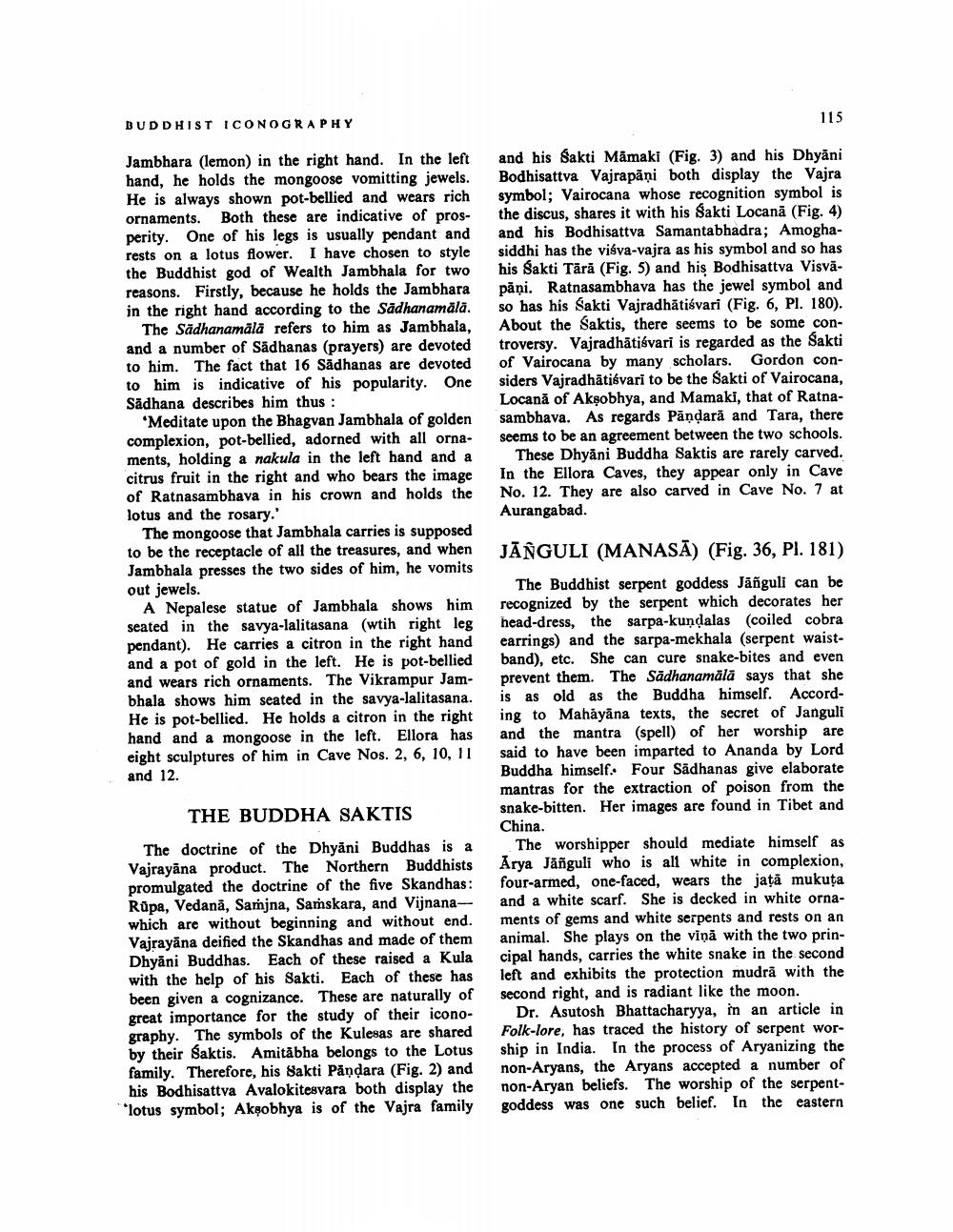________________
BUDDHIST ICONOGRAPHY
Jambhara (lemon) in the right hand. In the left hand, he holds the mongoose vomitting jewels. He is always shown pot-bellied and wears rich ornaments. Both these are indicative of prosperity. One of his legs is usually pendant and rests on a lotus flower. I have chosen to style the Buddhist god of Wealth Jambhala for two reasons. Firstly, because he holds the Jambhara in the right hand according to the Sadhanamälä.
The Sädhanamälä refers to him as Jambhala, and a number of Sadhanas (prayers) are devoted to him. The fact that 16 Sadhanas are devoted to him is indicative of his popularity. One Sadhana describes him thus:
'Meditate upon the Bhagvan Jambhala of golden complexion, pot-bellied, adorned with all ornaments, holding a nakula in the left hand and a citrus fruit in the right and who bears the image of Ratnasambhava in his crown and holds the lotus and the rosary.'
The mongoose that Jambhala carries is supposed to be the receptacle of all the treasures, and when Jambhala presses the two sides of him, he vomits out jewels.
A Nepalese statue of Jambhala shows him seated in the savya-lalitasana (wtih right leg pendant). He carries a citron in the right hand and a pot of gold in the left. He is pot-bellied and wears rich ornaments. The Vikrampur Jambhala shows him seated in the savya-lalitasana. He is pot-bellied. He holds a citron in the right hand and a mongoose in the left. Ellora has eight sculptures of him in Cave Nos. 2, 6, 10, 11 and 12.
THE BUDDHA SAKTIS
The doctrine of the Dhyani Buddhas is a Vajrayāna product. The Northern Buddhists promulgated the doctrine of the five Skandhas: Rūpa, Vedanā, Samjna, Samskara, and Vijnanawhich are without beginning and without end. Vajrayana deified the Skandhas and made of them Dhyani Buddhas. Each of these raised a Kula with the help of his Sakti. Each of these has been given a cognizance. These are naturally of great importance for the study of their iconography. The symbols of the Kulesas are shared by their Saktis. Amitabha belongs to the Lotus family. Therefore, his Sakti Pändara (Fig. 2) and his Bodhisattva Avalokitesvara both display the lotus symbol; Aksobhya is of the Vajra family
115
and his Sakti Māmaki (Fig. 3) and his Dhyani Bodhisattva Vajrapani both display the Vajra symbol; Vairocana whose recognition symbol is the discus, shares it with his Sakti Locană (Fig. 4) and his Bodhisattva Samantabhadra; Amoghasiddhi has the viśva-vajra as his symbol and so has his Sakti Tārā (Fig. 5) and his Bodhisattva Visväpāņi. Ratnasambhava has the jewel symbol and so has his Sakti Vajradhātiśvari (Fig. 6, Pl. 180). About the Saktis, there seems to be some controversy. Vajradhātiśvari is regarded as the Sakti of Vairocana by many scholars. Gordon considers Vajradhātiśvari to be the Sakti of Vairocana, Locanǎ of Akṣobhya, and Mamaki, that of Ratnasambhava. As regards Pāṇḍarā and Tara, there seems to be an agreement between the two schools.
These Dhyani Buddha Saktis are rarely carved. In the Ellora Caves, they appear only in Cave No. 12. They are also carved in Cave No. 7 at Aurangabad.
JANGULI (MANASA) (Fig. 36, Pl. 181)
The Buddhist serpent goddess Jāñguli can be recognized by the serpent which decorates her head-dress, the sarpa-kundalas (coiled cobra earrings) and the sarpa-mekhala (serpent waistband), etc. She can cure snake-bites and even prevent them. The Sadhanamālā says that she is as old as the Buddha himself. According to Mahayana texts, the secret of Janguli and the mantra (spell) of her worship are said to have been imparted to Ananda by Lord Buddha himself. Four Sadhanas give elaborate mantras for the extraction of poison from the snake-bitten. Her images are found in Tibet and China.
The worshipper should mediate himself as Arya Jañguli who is all white in complexion, four-armed, one-faced, wears the jață mukuta and a white scarf. She is decked in white ornaments of gems and white serpents and rests on an animal. She plays on the viņa with the two principal hands, carries the white snake in the second left and exhibits the protection mudra with the second right, and is radiant like the moon.
Dr. Asutosh Bhattacharyya, in an article in Folk-lore, has traced the history of serpent worship in India. In the process of Aryanizing the non-Aryans, the Aryans accepted a number of non-Aryan beliefs. The worship of the serpentgoddess was one such belief. In the eastern




